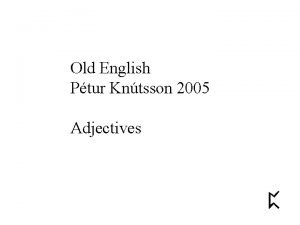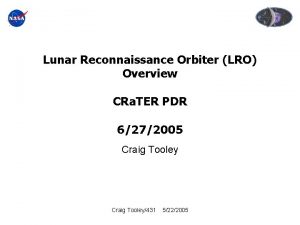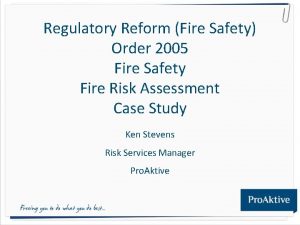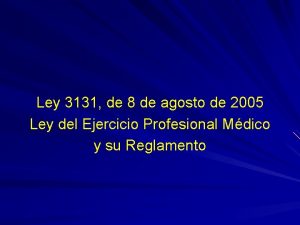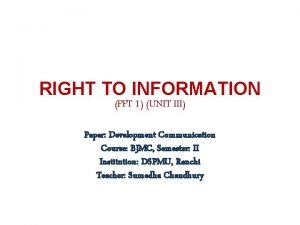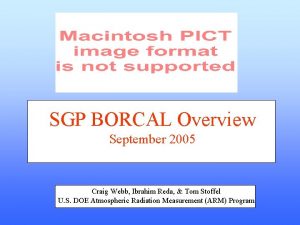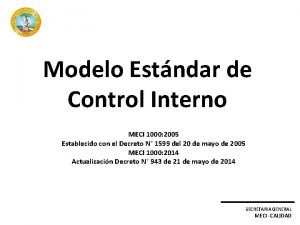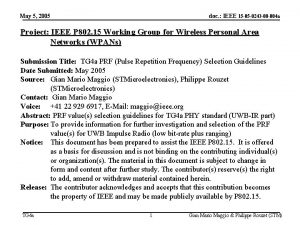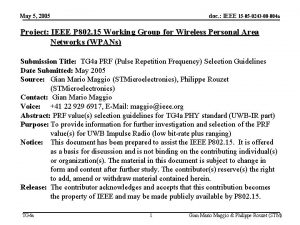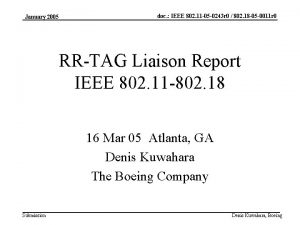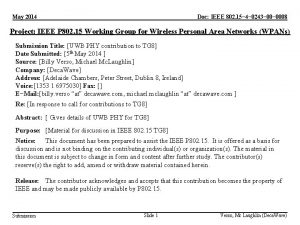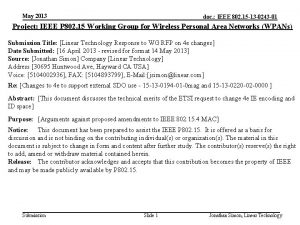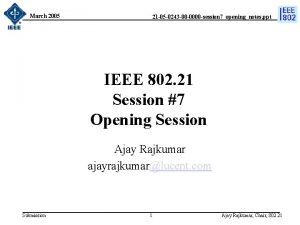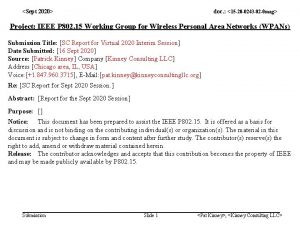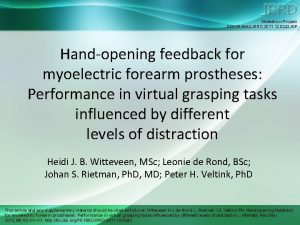May 5 2005 doc IEEE 15 05 0243













- Slides: 13

May 5, 2005 doc. : IEEE 15 -05 -0243 -00 -004 a Project: IEEE P 802. 15 Working Group for Wireless Personal Area Networks (WPANs) Submission Title: TG 4 a PRF (Pulse Repetition Frequency) Selection Guidelines Date Submitted: May 2005 Source: Gian Mario Maggio (STMicroelectronics), Philippe Rouzet (STMicroelectronics) Contact: Gian Mario Maggio Voice: +41 22 929 6917, E-Mail: maggio@ieee. org Abstract: PRF value(s) selection guidelines for TG 4 a PHY standard (UWB-IR part) Purpose: To provide information for further investigation and selection of the PRF value(s) for UWB Impulse Radio (low bit-rate plus ranging) Notice: This document has been prepared to assist the IEEE P 802. 15. It is offered as a basis for discussion and is not binding on the contributing individual(s) or organization(s). The material in this document is subject to change in form and content after further study. The contributor(s) reserve(s) the right to add, amend or withdraw material contained herein. Release: The contributor acknowledges and accepts that this contribution becomes the property of IEEE and may be made publicly available by P 802. 15. TG 4 a 1 Gian Mario Maggio & Philippe Rouzet (STM)

May 5, 2005 doc. : IEEE 15 -05 -0243 -00 -004 a PRF (Pulse Repetition Frequency) Selection Guidelines Gian Mario Maggio & Philippe Rouzet (STMicroelectronics) TG 4 a 2 Gian Mario Maggio & Philippe Rouzet (STM)

May 5, 2005 doc. : IEEE 15 -05 -0243 -00 -004 a PRF Selection Strategy • For each sub-band (mandatory + optionals), based on physical parameters, derive PRF range: – – • Optimize PRF value(s) based upon design parameters: – – TG 4 a Min PRF (technology, regulation, ranging, etc. ) Max PRF (channel delay spread, etc. ) Modulation/demodulation Acquisition Implementation … 3 Gian Mario Maggio & Philippe Rouzet (STM)

May 5, 2005 doc. : IEEE 15 -05 -0243 -00 -004 a PRF: Physical Parameters (1/2) UWB Radio PRF Bandwidth B PRF Comments The higher the bandwidth, B, the higher minimum required PRF @Vpp constant Scalable PRF (mandatory + optional) Baseline: CMOS 90 nm, max Vpp = 1 V (conservative) Technology Peak-to-Peak Voltage Vpp Channel Delay Spread Typical (indoor) channel delay spread in the range ~50 -120 ns Regulations Peak-to-Average Power Ratio Any “hidden” regulation limit? Higher PRF Better ranging accuracy Ranging Accuracy TG 4 a 4 Gian Mario Maggio & Philippe Rouzet (STM)

May 5, 2005 doc. : IEEE 15 -05 -0243 -00 -004 a PRF: Design Parameters (2/2) UWB Radio PRF BPPM + BPSK Mod/Demod Energy/Pulse Comments Low PRF high energy/pulse: challenging to generate, easier to detect (non-coherent) Coherent Integration Higher SNR Relax minimum energy/pulse For higher PRF, in general, it takes less time to acquire code synchronization Acquisition Time Complexity For lower PRF, the synch matched filter is smaller than for higher PRF Generally speaking, low PRF may result in lower cost (lower frequency) components Implementation Cost RX Dynamic Range ADC frequency TG 4 a Ex: 12 MHz PRF reduces the RX dynamic range by 7 d. B, compared to 60 MHz PRF Note: ADC frequency may be dictated by ranging requirements 5 Gian Mario Maggio & Philippe Rouzet (STM)

May 5, 2005 doc. : IEEE 15 -05 -0243 -00 -004 a Supporting Material a. b. c. d. TG 4 a I 2 R - Francois Chin (15 -05 -0231 -00 -004 a): PRF definition, Minimum PRF Wideband Access - Ismail Lakkis/Saeid Safavi (15 -05 -0226 -01 -004 a): Minimum PRF Wisair - Gadi Shor (15 -05 -0213 -00 -004 a): PRF proposals CEA-LETI/STM: PRP vs. pulse amplitude and peak power 6 Gian Mario Maggio & Philippe Rouzet (STM)

May 5, 2005 doc. : IEEE 15 -05 -0243 -00 -004 a (a) PRF: Definition • Pulse repetition frequency (PRF): Number of pulses occurring in 1 s. • Pulse repetition interval (PRI): Time from the beginning of one pulse to the beginning of the next. VPeak PRI TC TG 4 a 7 Gian Mario Maggio & Philippe Rouzet (STM)

May 5, 2005 doc. : IEEE 15 -05 -0243 -00 -004 a (a) PRF Definition: Example Pulse Repetition Interval 1 2 3 4 5 6 7 8 N-1 N …………… Non-inverted pulses are blue, Inverted pulses are green. ……………. . . . Quiet time Active time Symbol Interval TG 4 a 8 Gian Mario Maggio & Philippe Rouzet (STM)

May 5, 2005 doc. : IEEE 15 -05 -0243 -00 -004 a (a) Minimum PRF Requirements BW = 528 MHz Technology CMOS 90 nm 0. 7 Vpp TChip (nsec) 1. 9 Bipolar Ternary (equal ± 1 & 0) 0. 35 PAve (d. Bm) -14 PPeak (d. Bm) 1 -2 16. 5 33 Sequence VPeak (v) PRF (MHz) @ VPeak BW = 1584 MHz Technology CMOS 90 nm 0. 7 Vpp TChip (nsec) 0. 54 BW (MHz) Bipolar Ternary (equal ± 1 & 0) VPeak (v) 0. 35 PAve (d. Bm) -9. 3 PPeak (d. Bm) 1. 5 -1. 5 PRF (MHz) @ VPeak 132 264 TG 4 a 9 Gian Mario Maggio & Philippe Rouzet (STM)

May 5, 2005 doc. : IEEE 15 -05 -0243 -00 -004 a (b) Minimum PRF Requirements BW = 520 MHz Technology CMOS 90 nm 2. 5 Vpp CMOS 90 nm 1. 0 Vpp TChip (nsec) 1. 9 BW (MHz) 520 VPeak (v) 1. 25 0. 5 PAve (d. Bm) -14 -9. 4 PPeak (d. Bm) 12 4 PRF (MHz) @ VPeak 1. 3 8 Technology CMOS 90 nm 2. 5 Vpp CMOS 90 nm 1. 0 Vpp TChip (nsec) 1. 9 BW (MHz) 1560 VPeak (v) 1. 25 0. 5 PAve (d. Bm) -14 -9. 4 PPeak (d. Bm) 12 4 11. 5 72 BW = 1560 PRF (MHz) @ VPeak TG 4 a 10 Gian Mario Maggio & Philippe Rouzet (STM)

May 5, 2005 doc. : IEEE 15 -05 -0243 -00 -004 a (c) PRF Proposals • The PRF represents the rate of transmission of the basic pattern. The PRF is an integer division of all center frequencies. The basic PRF is 66 MHz. A PRF of 33 MHz is also supported for environments with long delay spread. • Justification: PRF can be generated from a PLL by dividing the center frequency down to the PRF. The first divisions can be based on the divisions implemented as part of the PLL. The center frequencies and PRF are selected such that the first two divisions for off the shelf XOs are divisions by 2. This simplifies the implementation of the high frequency division elements. TG 4 a 11 Gian Mario Maggio & Philippe Rouzet (STM)

May 5, 2005 doc. : IEEE 15 -05 -0243 -00 -004 a (d) PRP vs. Pulse Amplitude and Peak Power Fcc limit : 0 d. Bm (upper band only) TG 4 a 12 Gian Mario Maggio & Philippe Rouzet (STM)

May 5, 2005 doc. : IEEE 15 -05 -0243 -00 -004 a Conclusions (Preliminary) • Scalable PRF: – Bands supported: 500 MHz (mandatory), 1. 5 GHz • No. of supported PRF values: 2 (or more) • For CMOS 90 nm, PRF lower bound @500 MHz seems to be ~10 MHz • Proposed PRF values (so far): – Basic: 13/33 MHz – Optional: 26/66 MHz • PRI value to be dictated by sequence design • Note: PRF requirements may be mitigated by the adoption of multi-pulse chips TG 4 a 13 Gian Mario Maggio & Philippe Rouzet (STM)




